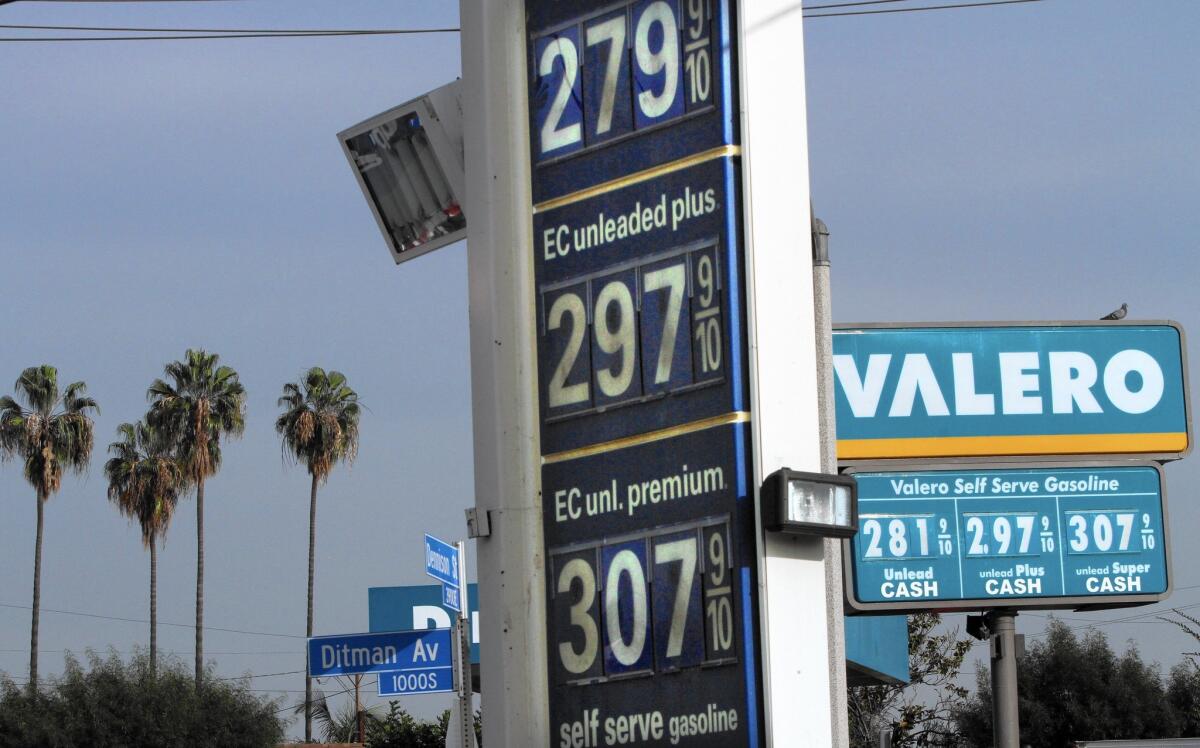Low gas prices can be problem

- Share via
Paul Kalt had reason to feel smug as he filled the tank of his 2014 Ford Edge SUV at a Mobil station on La Cienega. Regular gas was going for $2.90 a gallon.
Kalt told me it cost about $60 for a fill-up during the summer. Now he can get away with paying closer to $40.
“I’m feeling great about it,” Kalt, 45, said Wednesday. “It’s great to have extra money, especially now. The holidays are the most expensive time of the year.”
But is there a downside to low gas prices? Energy experts say yes.
“The American consumer is incredibly shortsighted,” said Jonathan Rubin, an energy economist at the University of Maine. “It’s very troubling.”
He and other academics say that while low gas prices have short-term economic benefits, there can be serious long-term consequences.
“Low gas prices can undo progress we’ve made in green technology,” said Chris Knittel, a professor of energy economics at the Massachusetts Institute of Technology. “People are less likely to adopt more fuel-efficient vehicles, and companies have less incentive to invest in new technologies.”
That’s not to say anyone’s complaining about low gas prices. I know I’m not.
Stocks rose Thursday for the first time in four trading days, in part because investors believe savings at the pump will translate into more ka-ching at retailers’ cash registers this holiday season.
Miguel Rivas bears out such optimism. I met him at a Chevron station where a gallon of unleaded was going for $2.96 a gallon. It was the first time since October 2010 that gas prices in Los Angeles County had dropped below $3 a gallon.
The Southern California price of a gallon of regular averaged $2.97 on Thursday, according to the Auto Club. A year ago, it was running $3.65. The statewide average is now $2.93 a gallon. The national average is $2.62.
Rivas, 58, said he used to spend about $400 a month filling his pickup truck. Now he spends closer to half that amount.
“That’s more money in my pocket,” he said. “It makes things a lot easier.”
It does. But I’m thinking that the question isn’t whether it’s sweet having some extra scratch at a particularly pricey time of year. The question is whether this is making a deeper problem even worse.
Look at it like this: Would crack addicts be able to kick the habit if the price of crack kept dropping?
In June 2010, President Obama said the U.S. must end its dependence on fossil fuels such as oil and natural gas. “The time has come, once and for all, for this nation to fully embrace a clean energy future,” he said.
That goal seemed more feasible as gas prices rose. Drivers abandoned gas guzzlers and snapped up more fuel-efficient, smaller cars.
By 2012, the Toyota Prius was the top-selling car in California. General Motors, Ford and Chrysler announced plans to work with colleges and universities to produce a new generation of engineers who could develop tomorrow’s electric and hybrid vehicles.
What a difference a few billion barrels of cheap oil make.
Low gas prices in November “drove popular hybrids and [electric vehicles] into the proverbial ditch,” reported Cars.com. Sales fell by double digits for the Prius, Ford C-Max, Chevy Volt and Honda Civic Hybrid.
At the same time, demand for pickup trucks and SUVs rose nearly 10%. While such vehicles are now more fuel-efficient than in years past, they still drink more fuel than smaller vehicles.
The concern, experts say, is that it will take years to reverse the effect of Americans’ renewed giddiness about big vehicles.
“It’s a lost opportunity,” said Maine’s Rubin. “New vehicles last for 16 years, on average. So whatever momentum we saw toward smaller cars will slow.”
Ashley Langer, an energy economist at the University of Arizona, said U.S. consumers routinely put blinders on when buying a new vehicle.
“They see the current price of gas as a forecast of what they can expect in the future,” she said. “But of course we can expect gas prices to go up again.”
There it is. Consumers may be enjoying a reprieve in being bullied at the gas pump. However, it’s all but inevitable that prices will surge higher.
“They might not jump next week or the week after,” said Richard Carson, a professor of energy economics at UC San Diego. “But longer term, they will go up.”
Oil is a finite resource, of course. Global supplies have to run out at some point. But Carson said a “Mad Max” scenario of worldwide fuel shortages and anarchy is a long way off.
A more likely outlook is that technology will improve for tapping oil reserves in hard-to-reach places, he said. The cost of extracting such oil will be higher, and that will be felt at the gas pump.
For the moment, though, oil prices are in the bargain basement. U.S. crude futures slipped below $60 a barrel Thursday for the first time in five years.
Most drivers I met this week gushed about the falling oil prices and said they expected gas to get even cheaper.
D.J. Moore, 49, was one of the few who sounded a more cautious note.
“I’m sure they’re not going to stay this way,” he said as he filled his car at a Mobil station. “When have prices ever gone down and stayed down? Prices on everything always go up.”
And that, in a nutshell, is why the SUV purchased today will come back to bite you tomorrow.
David Lazarus’ column runs Tuesdays and Fridays. He also can be seen daily on KTLA-TV Channel 5 and followed on Twitter @Davidlaz. Send your tips or feedback to david.lazarus@latimes.com.
More to Read
Inside the business of entertainment
The Wide Shot brings you news, analysis and insights on everything from streaming wars to production — and what it all means for the future.
You may occasionally receive promotional content from the Los Angeles Times.











